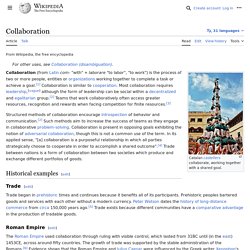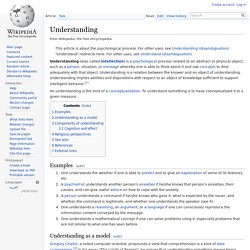

Collaboration. Act of working together Catalan castellers collaborate, working together with a shared goal Collaboration (from Latin com- "with" + laborare "to labor", "to work") is the process of two or more people, entities or organizations working together to complete a task or achieve a goal.[1] Collaboration is similar to cooperation.

Most collaboration requires leadership,[vague] although the form of leadership can be social within a decentralized and egalitarian group.[2] Teams that work collaboratively often access greater resources, recognition and rewards when facing competition for finite resources.[3] Structured methods of collaboration encourage introspection of behavior and communication.[2] Such methods aim to increase the success of teams as they engage in collaborative problem-solving. Partnership. A partnership is an arrangement in which parties agree to cooperate to advance their mutual interests.[1] Since humans are social beings, partnerships between individuals, businesses, interest-based organizations, schools, governments, and varied combinations thereof, have always been and remain commonplace.

In the most frequently associated instance of the term, a partnership is formed between one or more businesses in which partners (owners) co-labor to achieve and share profits and losses (see business partners). Partnerships exist within, and across, sectors. Non-profit, religious, and political organizations may partner together to increase the likelihood of each achieving their mission and to amplify their reach. In what is usually called an alliance, governments may partner to achieve their national interests, sometimes against allied governments holding contrary interests, as occurred during World War II and the Cold War. Common law[edit] There are two types of partners. Peace. Peace is an occurrence of harmony characterized by the lack of violence, conflict behaviors and the freedom from fear of violence.

Commonly understood as the absence of hostility and retribution, peace also suggests sincere attempts at reconciliation, the existence of healthy or newly healed interpersonal or international relationships, prosperity in matters of social or economic welfare, the establishment of equality, and a working political order that serves the true interests of all. Etymology[edit] The term 'peace' originates most recently from the Anglo-French pes, and the Old French pais, meaning "peace, reconciliation, silence, agreement" (11th century).[1] Pes itself comes from the Latin pax, meaning "compact, agreement, treaty of peace, tranquility, absence of hostility.
" The English word came into use in various personal greetings from c.1300 as a translation of the Hebrew shalom. Religious beliefs and peace [edit] Islam means submission. Inner peace[edit] Education. School children sitting in the shade of an orchard in Bamozai, near Gardez, Paktya Province, Afghanistan A right to education has been recognized by some governments.

Brain. This article compares the properties of brains across the entire range of animal species, with the greatest attention to vertebrates.

It deals with the human brain insofar as it shares the properties of other brains. The ways in which the human brain differs from other brains are covered in the human brain article. Several topics that might be covered here are instead covered there because much more can be said about them in a human context. The most important is brain disease and the effects of brain damage, covered in the human brain article because the most common diseases of the human brain either do not show up in other species, or else manifest themselves in different ways.
Anatomy[edit] Abstraction. Abstraction is a process by which concepts are derived from the usage and classification of literal ("real" or "concrete") concepts, first principles, or other methods.

"An abstraction" is the product of this process—a concept that acts as a super-categorical noun for all subordinate concepts, and connects any related concepts as a group, field, or category.[1] Abstractions may be formed by reducing the information content of a concept or an observable phenomenon, typically to retain only information which is relevant for a particular purpose.
For example, abstracting a leather soccer ball to the more general idea of a ball retains only the information on general ball attributes and behavior, eliminating the other characteristics of that particular ball.[1] Origins[edit] Thinking in abstractions is considered[by whom?] Abstraction involves induction of ideas or the synthesis of particular facts into one general theory about something.
Thought process[edit] Cat on Mat (picture 1) System. A schematic representation of a closed system and its boundary A system is a set of interacting or interdependent components forming an integrated whole.[1] Every system is delineated by its spatial and temporal boundaries, surrounded and influenced by its environment, described by its structure and purpose and expressed in its functioning.

Understanding. Understanding (also called intellection) is a psychological process related to an abstract or physical object, such as a person, situation, or message whereby one is able to think about it and use concepts to deal adequately with that object.

Understanding is a relation between the knower and an object of understanding. Understanding implies abilities and dispositions with respect to an object of knowledge sufficient to support intelligent behavior.[1] Frederic Vester. Frederic Vester (November 23, 1925 – November 2, 2003) was a German biochemist, and an expert in the field of ecology.

Biography[edit] Vester was born in Saarbrücken, and studied chemistry at the universities of Mainz, Paris and Hamburg. From 1955 to 1957 he was postdoctoral fellow at Yale University and Cambridge. From 1957 to 1966 he worked at Saarland University, Saarbrücken, and from 1969 he worked in Munich, first at the Max Planck Institute. In 1970 he founded the private Munich-based Frederic Vester Studiengruppe für Biologie und Umwelt GmbH ("Frederic Vester Study Group for Biology and Environment, Ltd.), renamed Frederic Vester GmbH ("Frederic Vester, Ltd. ") after his death. From 1982 to 1989 he was a professor at the Bundeswehr University Munich, and from 1989 to 1991 he was Professor for Applied Economics at the Hochschule St.
Work[edit] Health. Health is the level of functional or metabolic efficiency of a living organism.

In humans, it is the general condition of a person's mind and body, usually meaning to be free from illness, injury or pain (as in "good health" or "healthy").[1] The World Health Organization (WHO) defined health in its broader sense in 1946 as "a state of complete physical, mental, and social well-being and not merely the absence of disease or infirmity.
Systematic activities to prevent or cure health problems and promote good health in humans are undertaken by health care providers. Applications with regard to animal health are covered by the veterinary sciences. The term "healthy" is also widely used in the context of many types of non-living organizations and their impacts for the benefit of humans, such as in the sense of healthy communities, healthy cities or healthy environments.
Determinants[edit] The environment is often cited as an important factor influencing the health status of individuals. Priorisation. Red. Reduction (complexity) In computability theory and computational complexity theory, a reduction is an algorithm for transforming one problem into another problem. A reduction from one problem to another may be used to show that the second problem is as difficult as the first. The mathematical structure generated on a set of problems by the reductions of a particular type generally forms a preorder, whose equivalence classes may be used to define degrees of unsolvability and complexity classes. Intuitively, problem A is reducible to problem B if an algorithm for solving problem B efficiently (if it existed) could also be used as a subroutine to solve problem A efficiently.
When this is true, solving A cannot be harder than solving B. We write A ≤m B, usually with a subscript on the ≤ to indicate the type of reduction being used (m : mapping reduction, p : polynomial reduction). Often we find ourselves trying to solve a problem that is similar to a problem we've already solved. From rational numbers. We write. Inheritance. Terminology[edit] In law, an heir is a person who is entitled to receive a share of the deceased's (the person who died) property, subject to the rules of inheritance in the jurisdiction where the deceased (decedent) died or owned property at the time of death. A person does not become an heir before the death of the deceased, since the exact identity of the persons entitled to inherit is determined only then. Members of ruling noble or royal houses expected to become heirs are called heirs apparent if first in line and incapable of being displaced from inheriting by another claim; otherwise, they are heirs presumptive.
Priorisation. Abstraction.